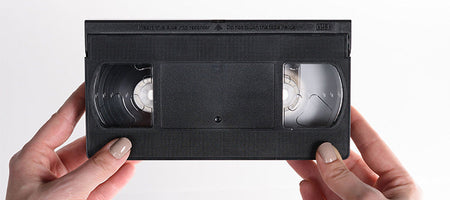First released by Sony in 1975, Betamax was a videotape format used by consumers for over 20 years. Even though Betamax was common for a few decades, the tapes were always behind the shadows of the prized VHS.
So why did Betamax lose traction while VHS became the most popular videotape device before DVDs?
Find out below as we go through the interesting history of Betamax tapes with these five fun facts.
-
Recording times on Betamax were drastically shorter than VHS
Betamax tapes were nearly half the size of VHS. Sony pushed hard to market the convenience of the size (in addition to the superior quality). However, the shorter recording time of Betamax was a huge problem for the amateur home video audience.
Most Betamax cassettes could only record up to an hour. Betamax’s longest cassette could record up to five hours, but this was still second-rate to some VHS tapes that could record over 10 hours of footage. A lot of consumers wanted to tape lengthy home videos of sports games and ceremonies, which was a big problem for Betamax.
-
Betamax was a major contender in the videotape format war
When VHS and Betamax were introduced to the consumer market, there was a heated debate on whether or not the movie industry should use one standardized format. JVC (VHS tapes) and Sony (Betamax) were head-to-head from 1974 into the 1980s.
The two companies were constantly coming out with updated videotape versions to try to outdo competitors. Oftentimes, Betamax tapes had a better quality than VHS, but VHS ultimately won the format war because of its lower retail price and longer recording time.
-
Betamax did well in the broadcast video industry
As we can see, Betamax didn’t reign supreme in the consumer video market as Sony envisioned. Yet there was a bit of a silver lining regarding Betamax industrial products. In 1982, Sony released the Betacam (a videotape targeted to professional filmmakers) and it quickly became the most used videotape format in electronic news gathering at the time.
-
ED-Beta tapes had the same resolution quality as DVDs
In 1988, Sony introduced the ED-Beta (Extended Definition) tapes which equaled the resolution quality of DVDs. It was Sony’s final hoorah for promoting the quality of Betamax and became the last consumer version of Beta to hit the market.
With up to 500 lines of resolution, a better contrast, and reduction of luminance noise, the ED-Beta tape became the most superior version of Betamax. Sony even marketed the tapes to semi-professional users. But alas, the DVD surpassed Betamax in sales.
-
Betamax held out for longer than perceived
When Sony lost the format war in the early 1980s, Betamax tapes were quickly losing traction with the consumer and home video market. The expensive price tag couldn’t compete with the affordability of VHS and VCRs.
By 1988, the Beta format officially stopped releasing new models. While most Americans thought Betamax was long gone by the 1990s, former Betamax tape models were in production until 2002. One main reason why Betamax held on for so long was because areas in South America and Japan still used the tapes regularly. Sony even continued to sell Betamax tapes up until 2016!













